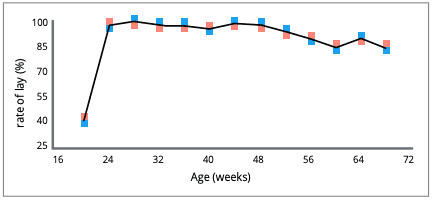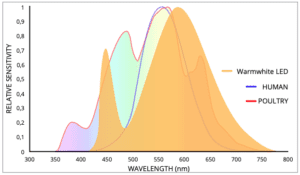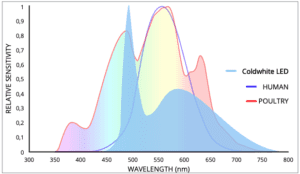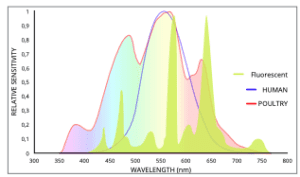How Layers Can Benefit From an Optimized Light Climate
by Stefan Lepelaars, Application Specialist – HATO Agricultural Lighting www.hato.lighting Lighting is extremely important in layer management and in general overlooked even though lighting controls the biological clock; the biorhythm of the chicken. Light is a powerful external stimulus that passes through the eyes and affects the photoreceptors in the retina. It influences bird behaviour such as social behaviour and overall activity.Deep-Brain Photoreceptors
Apart from the eyes, light passes through the skull. It reaches photoreceptors in the hypothalamus, in the pineal gland, in the preoptic area, and in the lateral septal organ. Light that reaches these deep-brain photoreceptors affects biological processes such as reproduction. Optimizing the influence of light and biological processes, and stimulating natural behaviour will help improve production and improve animal welfare. Light may not greatly improve production such as feed or ventilation, but a bad light climate threatens production.Photoperiod Basics
The light climate consists of the photoperiod, the light intensity, the light spectrum, the light distribution, and the light source. Getting all these factors right will create an optimal light climate. The photoperiod is the day length, the opposite of the scotoperiod; the night. Artificial lighting is a necessity when you want to use photoperiod as a tool to optimize production. In general, there are three different periods in a layer’s life that require a specific photoperiod. The first period, which basically consists of the first one or two days right after the pullets have left their eggs, requires a long photoperiod of 23 hours. A long photoperiod is needed in order to provide the newly hatched pullets with enough time to find water and feed and to set a big step in their adaptation to their new environment. The goal of the second period, the rearing period, is to get the layer to the right body weight before photostimulation which is needed for sexual maturation. To avoid photostimulation during the rearing period a short photoperiod of circa 9 hours must be applied. After circa 16 weeks, the pullets are transferred to the layer house and the third period starts. This period – the production period – is all about photostimulation.Photostimulation
The hens get photostimulated by increasing the photoperiod from circa 9 hours to 10 – 11 hours for white layers and to 13 – 14 hours for brown layers. Photostimulation consists of activating biological processes, in this case, sexual maturation, with the use of (an increase in photoperiod) light. Light reaching the deep-brain photoreceptors stimulates a hormonal cascade affecting the reproductive system; realizing sexual maturation. Increasing the photoperiod in one or in multiple steps does not make a difference in egg production (see Fig. 1).
Fig. 1. Rate of lay for laying hens transferred abruptly (blue), or in a series of 30 minute increments (red) from 8 – 14 hours at 18 weeks of age (unpublished data, University of Guelph).
Adaptation and Light
The right light intensity and the right light distribution are two other important factors in creating the optimal light climate. Paired with a long photoperiod during the first 48 hours, a high light intensity aids your pullets in finding feed and water and in their adaptation to their new home. After the first 48 hours light intensity is generally decreased to circa 10 – 15 lux and regulated based on bird behaviour. Post transfer (start of the production period) light intensity may be higher if you want to ensure proper photostimulation. Do not lower light intensity below 10 – 15 lux as a precaution. Lowering your light intensity is a tool with which you can decrease activity as a response to unwanted behaviour, such as feather pecking. You lose lowering your light intensity – dimming – as a tool when you start off with a light intensity lower than 10-15 lux.Get the Right Light at the Right Place
The average light intensity in your house may differ though. It is important to get the right light at the right place. You can divide a house into two different types of areas; an activity area and a resting area. In traditional cage housing, the feed gutter is the activity area, however, in an aviary, the feeding area and the litter area are the main activity areas. These activity areas must have a proper light distribution, meaning no bright spots and shadows in order to prevent floor eggs and clustering. Resting areas –mainly nesting areas –must have lower light intensities than the activity areas. They must not be in total darkness, as low light intensity is more inviting to layers to rest or lay eggs. The area below the aviary is prone to floor eggs. A very high light intensity may provide the stimulus that prevents layers from laying eggs there.Spectral Sensitivity
Poultry see the world differently than we humans do. This is due to the difference between our eyes. Eyes contain cones and rods, these are photoreceptor cells. Cones are responsible for sight in photopic, well-lit, conditions. Cones realize colour vision. Poultry have four different kinds of cones, whereas humans have three different kinds of cones. The fourth cone is responsible for vision in the ultraviolet part of the light spectrum. Apart from the fact that poultry have an additional fourth cone, the cones have a greater spectral sensitivity than those of humans. Because of the difference in spectral sensitivity to the different wavelengths – including the ultraviolet part of the spectrum – there is a difference in the perception of light intensity. Almost every part of the spectrum is perceived higher by poultry than by humans. Due to this poultry perceive light differently than humans. This means different spectrums lead to different outcomes in intensity perception. Fig. 2, 3, and 4 show how different spectrums affect poultry intensity perception.
Fig 2. WARMWHITE LED
Human versus poultry spectral sensitivity

Fig 3. COLDWHITE LED
Human versus poultry spectral sensitivity
Daylight Simulation
An optimal light spectrum is mandatory for chickens. The natural provided spectrum is that of daylight which ought to be the most optimal (see Fig. 5 for the natural spectrum of daylight). Longer wavelengths which are capable of penetrating the skin, feathers, and eventually the skull, are needed for proper stimulation of sexual maturation. Shorter wavelengths are not capable of finding their way through the avian skull. They are however part of the natural daylight spectrum and therefore needed in order to provide the hen with an optimal light climate. The provided light climate needs to match the needs of the chicken. A light climate that does not respond to the hen’s specific spectrum needs will degrade the hen’s ability to distinguish details and therefore optimal usage of the environment will degrade as well. A spectrum close to that of natural daylight stimulates natural behaviour. Monochromatic colour lighting degrades the hen’s vision due to a minimal available spectrum. However, when you want to degrade the hen’s vision to decrease the hen’s activity, monochromatic colour lighting is an important tool to have.
Fig 3. Fluorescent
Human versus poultry spectral sensitivity

Fig 5. Natural daylight
spectrum